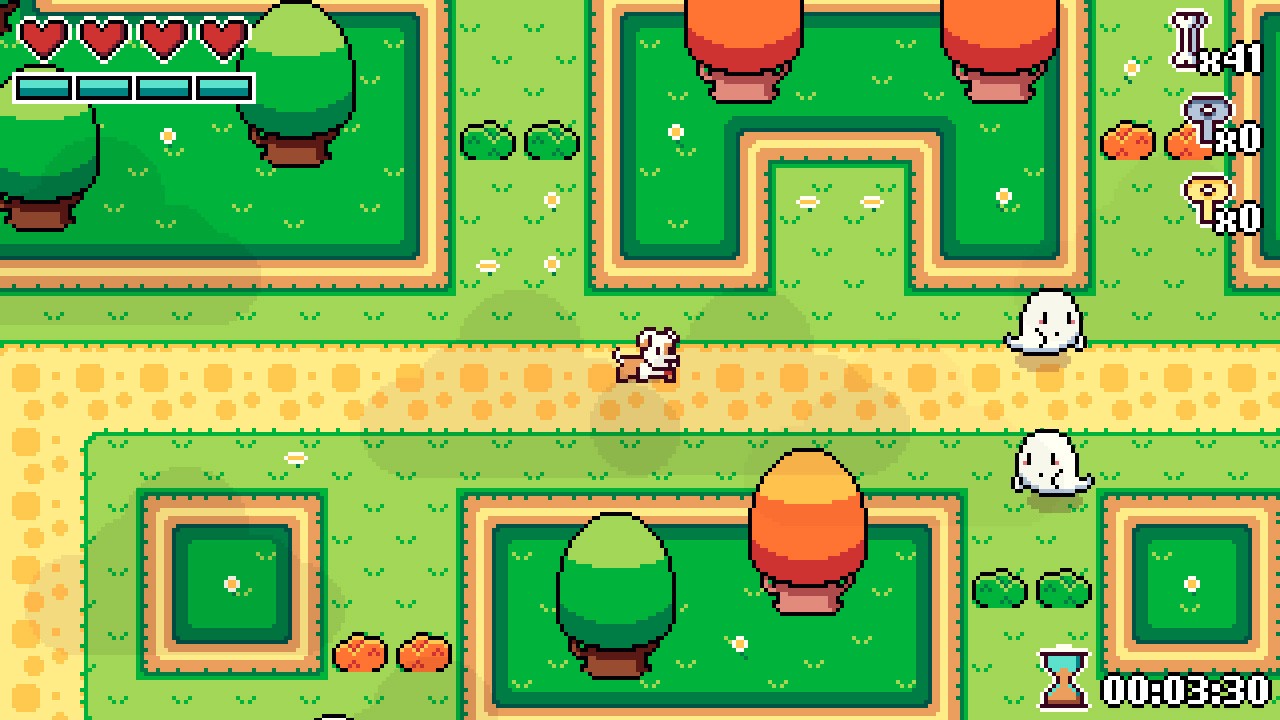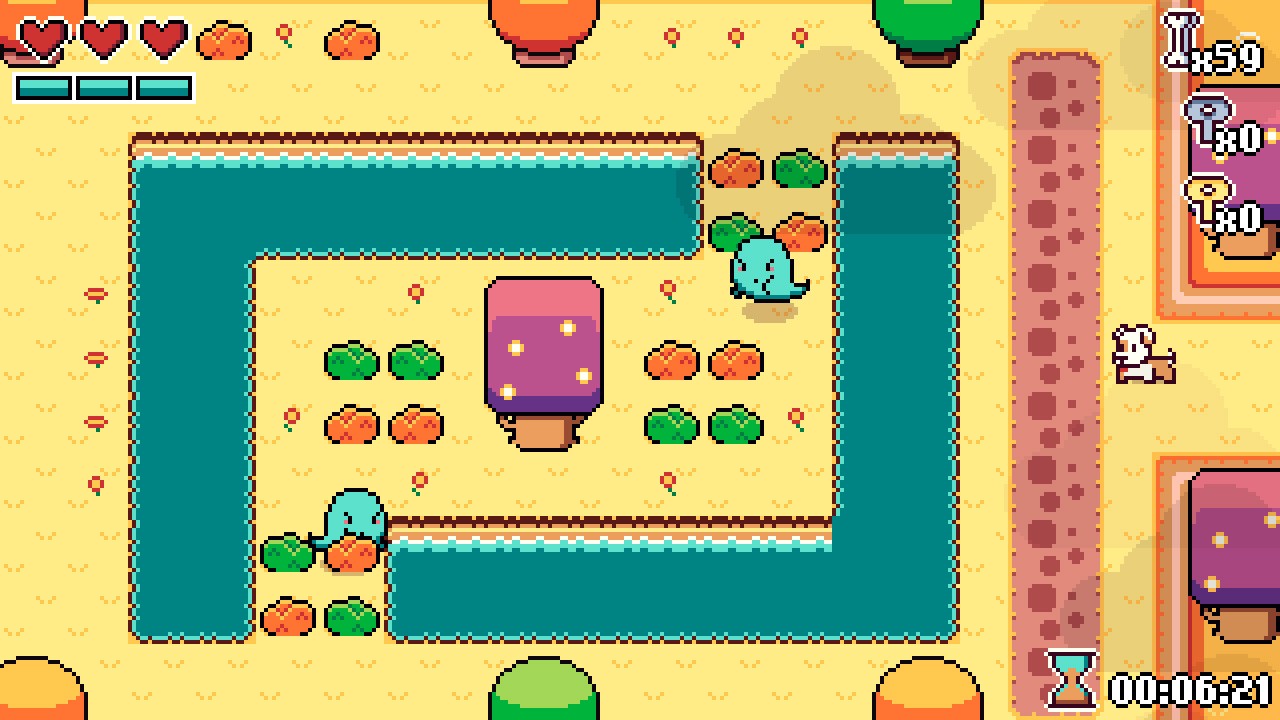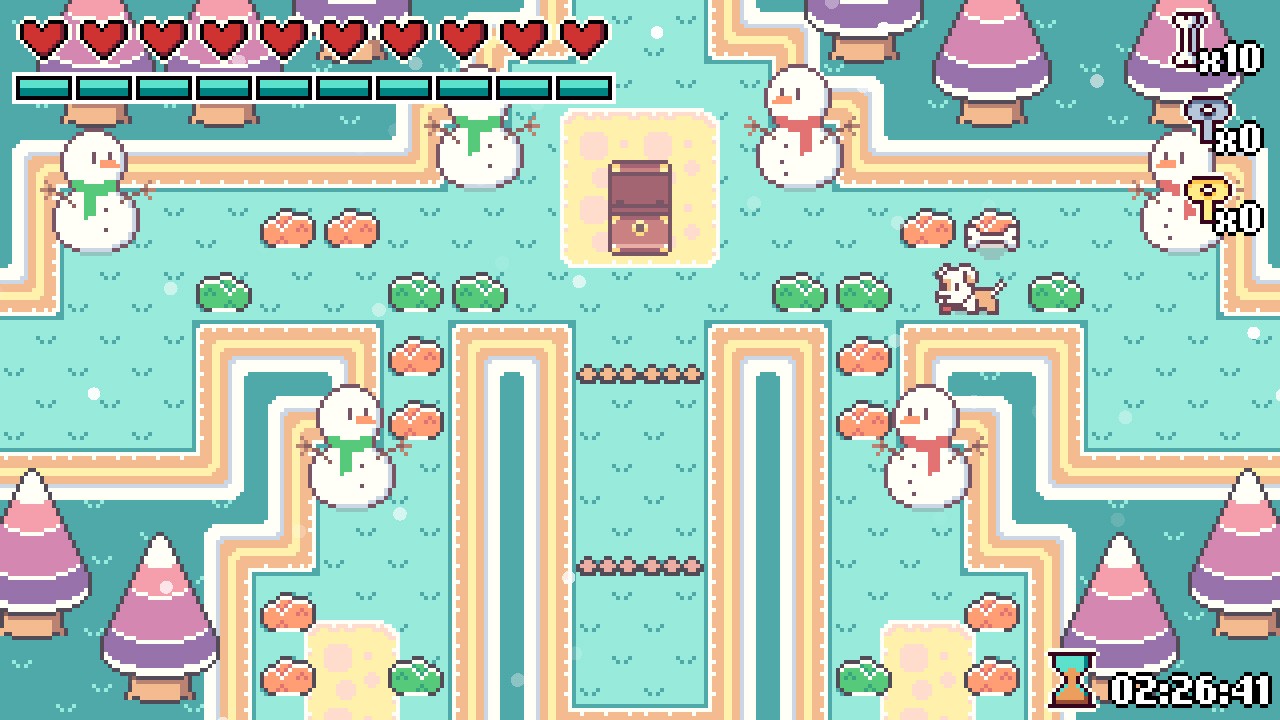
If you are tired of the standard puzzle adventure game, involving a human warrior setting out to save the land from an evil overlord, then Milo’s Quest may offer that change of pace for you. From the picture it isn’t hard to guess the main difference. Yes, you play as Milo the dog. His quest starts when he is innocently playing in the park and finds some bones lying around. Being a dog, resisting bones is impossible, but grabbing the bones accidentally releases the Evil King Lord Skull. Milo, being the good boy that he is, rectifies his mistake and sets out to defeat the recently released demon lord. Let’s find out if it is worth joining Milo on his quest.
A good starting point to talk about Milo’s Quest is in the amount of accessibility the game offers straight off the bat. With the standard three modes of difficulty, beginning with easy for those who just want to have a bit of fun with more items and unlimited lives, and building up to hard that only gives you one life and fewer items. Not only that, there is even the choice to to focus on either puzzles or adventuring, outside of the standard mode of both. It is an interesting range of customisation from the outset, allowing the player to tailor the game to what they want, which is a great idea. Particularly for replaying the game and wanting to focus on a certain aspect. This is only enhanced in the pause menu that is mostly a range of settings you can tweak, allowing it to appeal to everyone. Not really something I expected going in, but will praise it nonetheless.
Exploring the world involves navigating individual sections of a grid world map, like in the original The Legend of Zelda. Although there is a major difference in the sense these sections aren’t always rectangular in shape, having a mixture of wider or narrower screens, providing a lot more variation and helps draw you in to explore further. On the flip of this, despite being a top down view, you cannot always see the whole section at once and it will move with you around the section. However, finding the binoculars allows you to move the camera more freely. A major criticism is there is no world map, making it a pain to navigate to either the next section or remembering where something was to go back to. It is really frustrating, creating a bit of a barrier to complete the whole game, the last region of the game is quite wide and a bit maze like.

As Milo explores, he will encounter Evil King Lord Skull’s minions who will try to take him down. These minions are all ghosts, getting more complex as you progress. There is a basic one that won’t really proactively attack you other than an attempt to scare you with a boo (that does no damage). At first these are a standard creamy white, but later on there are transparent versions which are harder to spot. Blue ghosts will charge at you once you get close, and the last kind are mages that have a range attack. Despite only being three kinds, it is enough and manages to get introduced at a stable rate to challenge you in different ways yet they all take 2 hits to defeat which feels off. Feels like it should be different for the different types. There are also boss fights, although these are only about dodging and hitting… All enemies are defeated by Milo’s attack of a dash forward. As it’s a dash its a bit of a pain as it is too easy to just miss an enemy and Milo becoming the victim. Still, it is simple enough and once you get used to it there isn’t much issue.
Moving on to the puzzle aspect of Milo’s Quest involves moving blocks to cover switches in-order to open gates to either the next area or some sort of collectable. Generally, these are quite straightforward and get more complex at the right pace. Still, if you are used to these kinds of puzzles, even the hardest ones are pretty easy. Where other gates open by using silver keys or defeating all the enemies, all denoted by colour, it is a shame there isn’t at least another more puzzle focused mechanic to mix it up as it gets a little repetitive. Not only that, when gates get activated, the screen will quickly zoom over and come back to where you are but as it doesn’t centralise, it’s easy to miss what happened. Still, at least the puzzles are either to progress or get some form of collectibles to vary it somewhat. These collectibles range from health/stamina enhancers, chests (which need a gold key to open), and keys themselves. Notably, when you collect an item, the screen notifying you of this appears for what feels like forever. It only needs to be up for half the time and gets a bit annoying after a while. Lastly, on this front, the sort of currency in the game is bones. Collecting 50 of these can be used to open certain gates to gain collectables. Most of the time it seems like a fine trade, however, there are some that you open for a chest which then contains 8 bones which seems pointless… Infuriating if you died on the way as there is a loss of proportion of bones upon death… Still at least they are easy enough to come by.

As you can see from the screenshots Milo’s Quest graphically has an 8-Bit style. Clearly inspired by Nintendo classics such as the pre-mentioned The Legend of Zelda, Kirby, and so forth, it has a Nintendo feel to it if you ask me. Playing this on Switch, when docked the screen looks a bit stretched, but undocked has a smoother look to it making it the best way to play. Even more so when thinking about it, Milo’s Quest feels like it would be at home on the Game Boy Colour. Nonetheless, the colours are charming, fitting the tone of the game quite well. There are random weather effects of rain and snow that are cool, but ultimately serves little purpose as they do not influence gameplay in any shape or form. It would be better if it happened in certain sections of the map to help with navigation, but the random nature only adds to the disorientation. As it only really has an aesthetic function, I ended up turning if off as it becomes too distracting and not worth how nice it looked. Either way, moving on to the music that follows up the retro-feel by being chiptune. Generally written quite well, with the overworld theme being a real catchy tune at first, but it gets a bit too repetitive as the game goes on.
Really, when it comes together Milo’s Quest is quite simple. From all the points mentioned above it feels as it was intended to just be that way. Beating the whole game, and by that I mean 102% of the game due to the extra puzzle postgame, will take about 2 and a half hours for a competent gamer. If you are in for some fun, Milo’s Quest could be just that. It isn’t to be taken seriously and ultimately it isn’t ground breaking in any way. With a few tweaks it could be a perfect game to rush through and relax with every now but as it stands I can’t see much of an urge to ever load up the game again. Still, it is a perfect game for beginners and young children who would get a lot more out of this and really it is who the game should be more aimed at and feels a value for money at its price point.
REVIEW CODE: A complimentary Nintendo Switch code was provided to Bonus Stage for this review. Please send all review code enquiries to press@4gn.co.uk.
Subscribe to our mailing list
Get the latest game reviews, news, features, and more straight to your inbox
Thank you for subscribing to Bonus Stage.
Something went wrong.
Milo's Quest Review
-
Gameplay - 6/10
6/10
-
Graphics - 8/10
8/10
-
Sound - 6/10
6/10
-
Replay Value - 4/10
4/10
User Review
( votes)Overall
Summary
Milo’s Quest is a fun and straightforward adventure game, more enjoyable for younger and more causal players. The 8-bit graphics and chiptune tracks are heartwarmingly nostalgic, it can provide a couple of hours of relaxation. Although if you are looking for something challenging, this game isn’t going to be for you.
Pros
- Great 8-bit graphics.
- A lot accessibility and setting to shape the game.
Cons
- Lack of World Map makes it challenge to navigate at times.
- Too basic for more experienced gamers.





